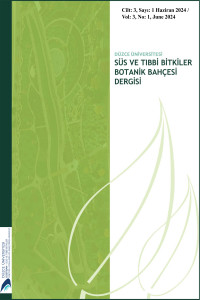Abstract
Bu çalışmada, bitkiler aleminin yaşayan en kalabalık ikinci grubunu oluşturan karayosunlarının, botanik bahçelerinde doğal olarak yayılışa sahip olanların belirlenmesinin, bu taksonların, egzotik taksonlarla birlikte sergilenmesinin ve konu üzerine gerçekleştirilecek diğer çalışmaların önemi ele alınmıştır. Ayrıca giderek artan bir şekilde gündeme gelen karayosunu bahçeleri ve peyzaj alanlarında kullana bilirlikleri derlenmiş ve ülkemizde farklı biyoçoğrafik bölgelerde oluşturulacak karayosunu bahçelerinde kullanılma potansiyeli olan taksonlar belirtilmiştir.
Keywords
Supporting Institution
TÜBİTAK
Project Number
TBAG 119Z393
Thanks
Bu çalışma TÜBİTAK (119Z393 ) tarafından desteklenmiştir. Bu güzide kurumumuza desteklerinden ve bilime sağladığı katkılardan dolayı teşekkür ederiz. Ayrıca arazi çalışmalarında desteklerini esirgemeyen Prof. Dr. Hatice ÖZENOĞLU ve Doktora öğrencisi Uğur ÇATAK'a teşekkürlerimizi bir borç biliriz.
References
- Adams, D.G. & Duggan, P.S. (2008). Cyanobacteria-bryophyte symbioses. J. Exp. Bot., 59(5), 1047-1058. Antonelli, A. (2022). Gizli Evren: Biyoçeşitlilik Maceraları. Witness Books.
- Aslan, G. (2022). Aydın Dağları Karayosunları Florası. Doktora Tezi, Aydın Adnan Menderes Üniversitesi Fen Bilimleri Enstitüsü, Aydın.
- BGCI (2023). https://www.bgci.org/our-work/inspiring-and-leading-people/where-we-work/europe/, Erişim Tarihi: 30.12.2023
- Burch, J. & T. Wilkinson (2002). Cryopreservation of protonemata of Ditrichum cornubicum (Paton) comparing the effectiveness of four cryoprotectant pretreatments. Cryoletters, 23(3), 197-208.
- Campisi, P., Dia, M.G. & Varshanidze, D. (2021). Introduction to the study of the bryological flora of the Batumi Botanical Garden (Georgia). Fl. Medit., 31(Special Issue), 125-130.
- Chiaffredom, M.K. (2004) When mosses recreate the landscape on the roof. MCK Environment & Bryotec Technology, Arzal.
- Chmielewski, M.W. & Eppley, S.M. (2019). Forest passerines as a novel dispersal vector of viable bryophyte propagules. Proceed. Royal Soc. B: Biol. Sci., 286(1897), 2018-2253. https://doi.org/10.1098/rspb.2018.2253
- Christenhusz, M.J.M. & Byng, J.W. (2016). The number of known plants species in the world and its annual increase. Phytotaxa, 261(3), 201-217.
- Crum, H. (2001). Structural Diversity of Bryophytes. Ann Arbor: University of Michigan Herbarium. Delgadillo, C. & Ángeles, C.S. (2000). Urban mosses in Mexico City. Serie Bot., 71(2), 63-72.
- Fine Gardening (2023-a). Tips for Creating a Moss Garden, https://www.finegardening.com/article/tips-for-creating-a-moss-garden, Erişim Tarihi: 30.10.2023
- Fine Gardening, (2023-b). Moss Makes a Lush Carpet, https://www.finegardening.com/article/moss-makes-a-lush-carpet, Erişim Tarihi: 30.10.2023
- Gavini, S.S., Suárez, G.M., Ezcurra, C. & Aizen, M.A. (2019). Facilitation of vascular plants by cushion mosses in high-Andean communities. Alpine Bot., 129(2), 137–148. https://doi.org/10.1007/s00035-019-00222-6 Gignac, L. D. (2001). Bryophytes as Indicators of Climate Change. The Bryol., 104(3), 410-420.
- Glime, J. M. (2017). Gardening: Moss garden development and maintenance. Chapter 7-4. In: Glime, J.M. (Ed.). Bryophyte Ecology, 5: 1-22, Houghton.
- Godovičová, K. (2017). Bryophytes of the Botanical Garden of the Comenius University in Bratislava. Acta Bot. Univ. Comen., 52, 29-34. https://doi.org/10.7320/FlMedit31SI.125
Details
| Primary Language | Turkish |
|---|---|
| Subjects | Plant Material and Growing, Green Structures and Environments, Forest Botany |
| Journal Section | Süs ve Tıbbi Bitkiler Botanik Bahçesi Dergisi 3(1) |
| Authors | |
| Project Number | TBAG 119Z393 |
| Publication Date | June 30, 2024 |
| Submission Date | January 4, 2024 |
| Acceptance Date | January 21, 2024 |
| Published in Issue | Year 2024 Volume: 3 Issue: 1 |

